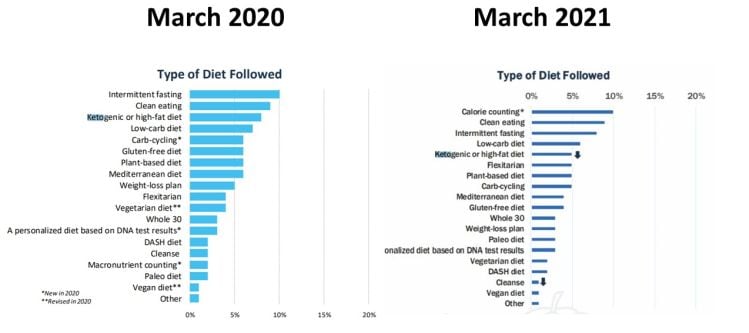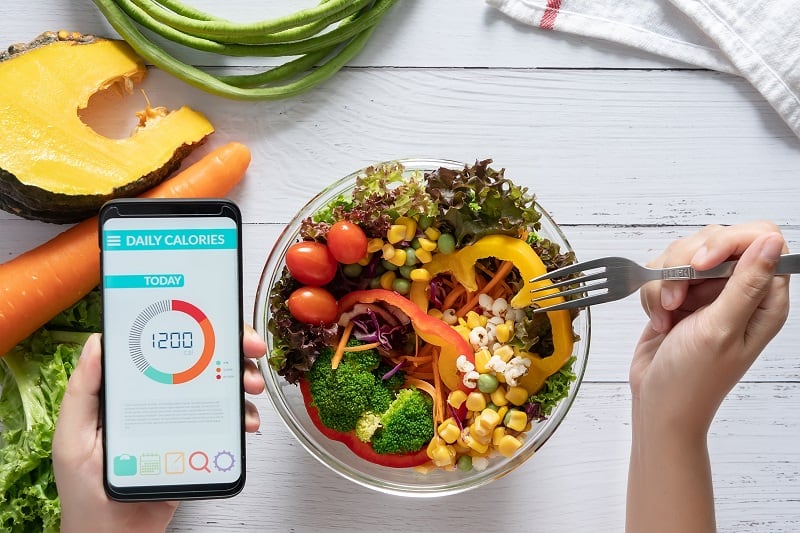IFIC’s 16th annual Food & Health Survey released today found four in ten of the 1,014 Americans aged 18-80 years contacted in late March reported following a diet or eating pattern in 2020 – with the highest concentration among younger consumers 18-34 years old (52% vs. 33% older than 35 years), women (43% vs 34% of men), Hispanics (50% vs 34% of non-Hispanic whites) and parents with children younger than 18 years (53% vs 34% without children under 18 years).
While there were “no big shifts in the number of people who followed a diet” there were big shifts in the types of diets they followed and why they followed them, said Ali Webster, director of research and nutrition communications at IFIC.
For example, she explained the top diet trend in 2020 wasn’t a buzzy fad with complicated rules about when to eat or what to eat – rather it was old-fashioned calorie-counting.
“Something that has been around forever, super-basic, [was] actually the most popular diet type that we’ve seen this year. That jumped to the top right away, and beat out other options like clean-eating and intermittent fasting, which are in the top three,” she explained.
Notably, the rise in popularity of calorie-counting pushed down other diets that have stolen the spotlight in recent years and dominated product innovation and marketing strategies, including the ketogenic diet or high-fat diet, which fell to account for roughly 5% of the dieters’ choice compared with around 8% in last year's survey. However, the slightly broader low-carb diet, which follows many of the same tenets as Keto came in one notch higher in fourth place with just over 5% of dieters, according to IFIC.

The percentage of Americans following some type of “cleanse,” which IFIC did not define, also dropped last year to about 1-2%, but as Webster notes “a very small fraction of Americans” have traditionally reported following a cleanse.
While the research didn’t specifically explore what was behind the drop in Keto, Webster hypothesized that the diet may have been too complicated for many Americans in a year filled with so much uncertainty and anxiety related to the pandemic.
“This year involved a lot of stressors and involved a lot of anxiety with people turning toward comfort food, towards things that were familiar to them to feel good – at least for a little while – emotionally and psychologically. And, so I wonder if it was just a lower priority for people to be restricting themselves in such a way … when we were spending so much time at home and had so many other things on our mind,” she explained.
Noting the keto diet is “notoriously” difficult to follow, Webster added that consumers interested in dieting likely opted for something more straight-forward, such as calorie-counting, or even intermittent fasting, which restricts when people eat but not what they eat.
She also noted that the keto diet didn’t allow for participation in other major dietary trends in 2020, including the country’s obsession with sourdough and baking in general.
Long-term health rises as a top diet motivator
Why consumers opted to diet also shifted last year to reflect the reality of pandemic-living, with more people noting they were motivated for health and wellness reasons, according to IFIC.
While the top motivator for adopting a diet remained losing weight at just under 40%, Webster noted fewer people were focused on this reason than prior years. Similarly, she said dieting to improve physical appearance, which accounted for just under 30%, also fell compared to prior years.
Webster hypothesized that fewer people dieted for their physical appearance because looks weren’t as top of mind in the past year with most people spending the majority of their time at home and with only immediate friends or family compared to previous years when people have been more mobile.
“We’ll see how this shifts next year as we kind of move back toward our normal lifestyles,” she added.
A very close second to wanting to lose weight was adopting a diet to protect long-term health or prevent future health conditions, according to IFIC. Wanting to feel better and have more energy was the third most prevalent motivator followed by wanting to better manage a health condition.
The importance of health as a motivator was particularly high among older dieters, according to IFIC, which found 61% of people 65 years and older tried a diet to protect their long-term health or prevent a future health condition versus 30% of 18- to 49-year-olds.
Likewise, 20% of parents with children under 18 years said they tried a diet because they wanted to follow the dietary guidelines or My Plate recommendations versus 6% of those without children, according to the study.
Consumers want more information about immunity and diet
Americans’ increased focus on the role of diet and nutrition on their health also shined a spotlight on immunity in 2020, but for all the marketing around immune-boosting and support, IFIC found two out of three Americans wanted more information about the role that foods and nutrients play in immunity.
“People are hungry for information in this area and I think it is a great opportunity to provide clear science-based information on this since we know that this is a very complicated topic and one with a lot of nuance,” Webster said.
However, she added, “that nuance isn’t necessarily demonstrated in a lot of the conversations around immune health and immune boosting. Whether or not that is even possible, I think this is a great opportunity for media, dietitians and people who are public-facing to be providing some clarity and some additional context for people on this issue.”
According to IFIC, consumers who are most interested in learning about the role of diet and nutrition in immunity are those with incomes of $35,000 or more (versus 55% of consumes with a lower income), parents of children under 18 years (74% versus 64% of those without children under 18 years) and online grocery shoppers (71% versus 60% of people who never buy groceries online).
How Americans will continue to factor immunity into their diet decisions as the pandemic ebbs remains to be seen, but Webster said she believes it is a “general wellness trend that doesn’t seem to be going away, at least immediately, as the pandemic subsides.”
However, she acknowledged, it may be less top of mind or “so uniquely focused on the issue fo food and health and our immune system” going forward.




